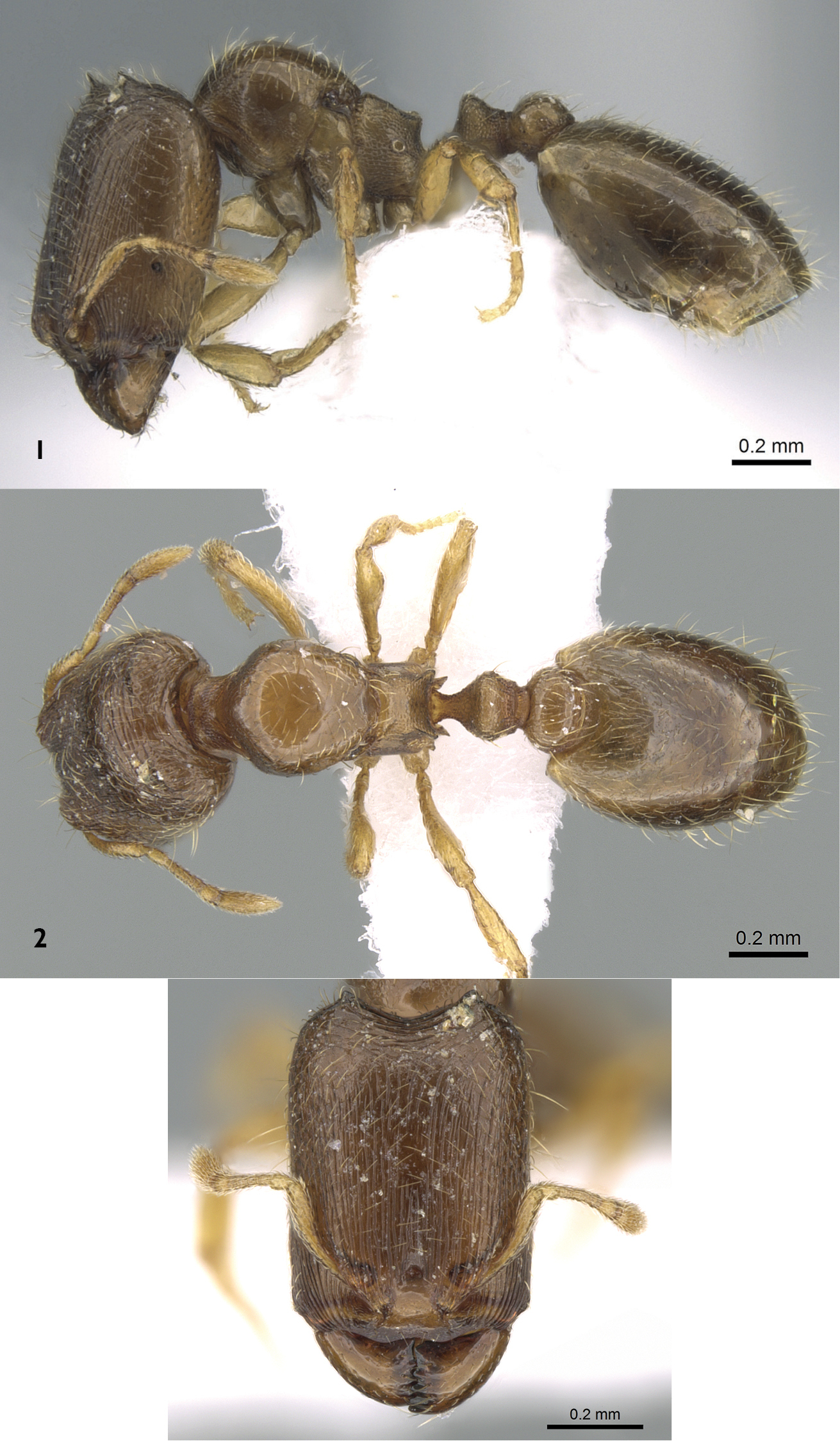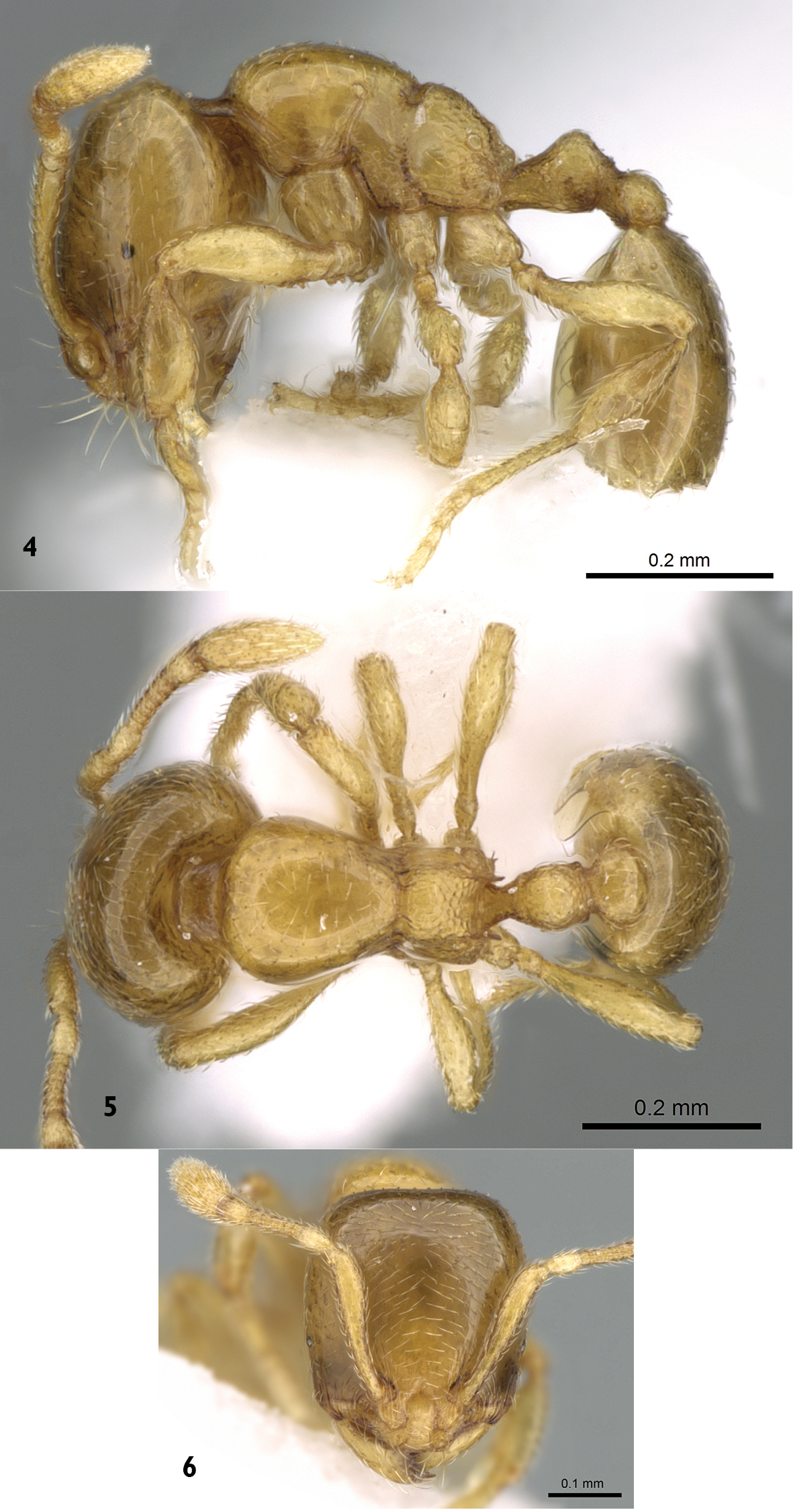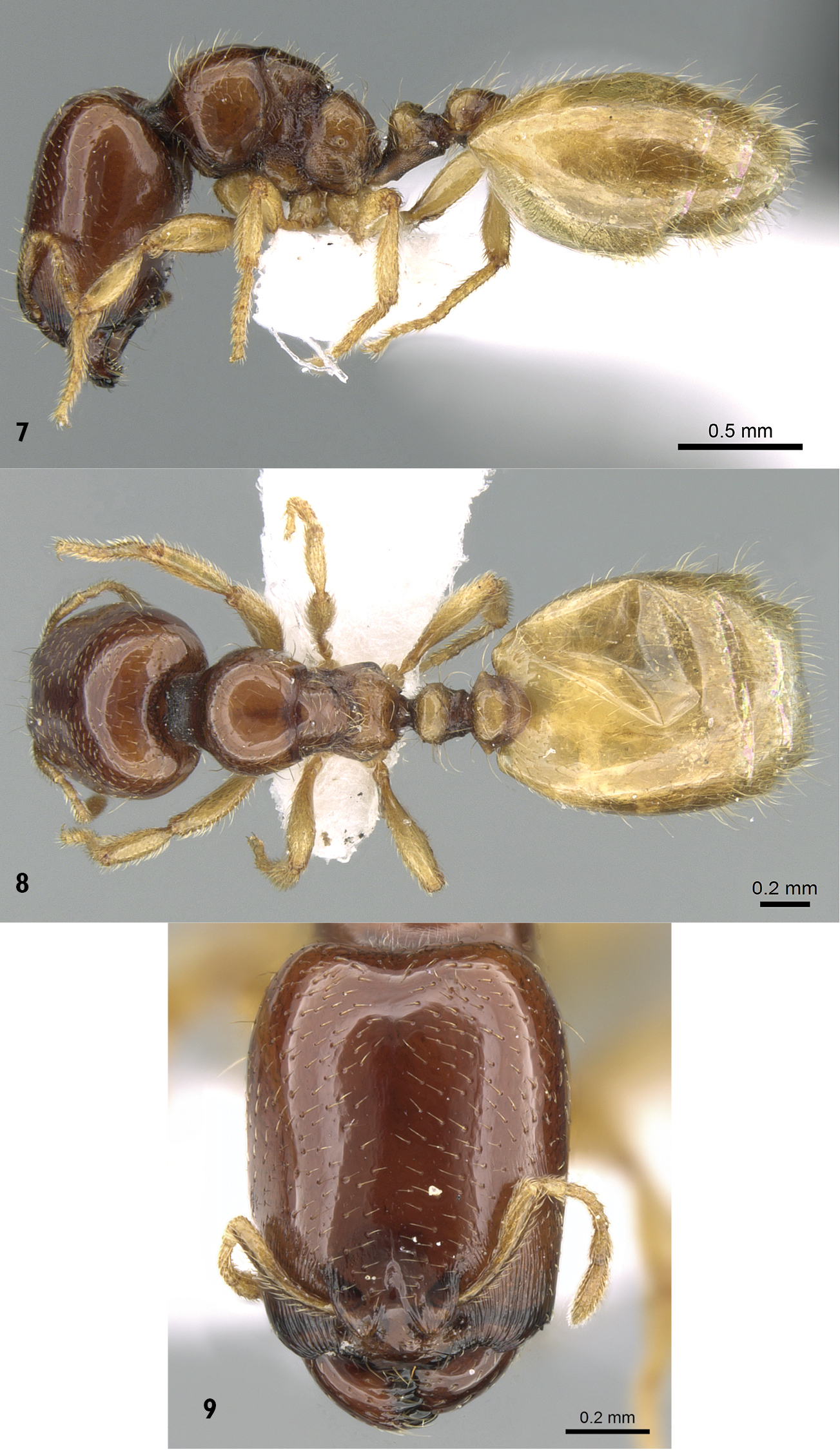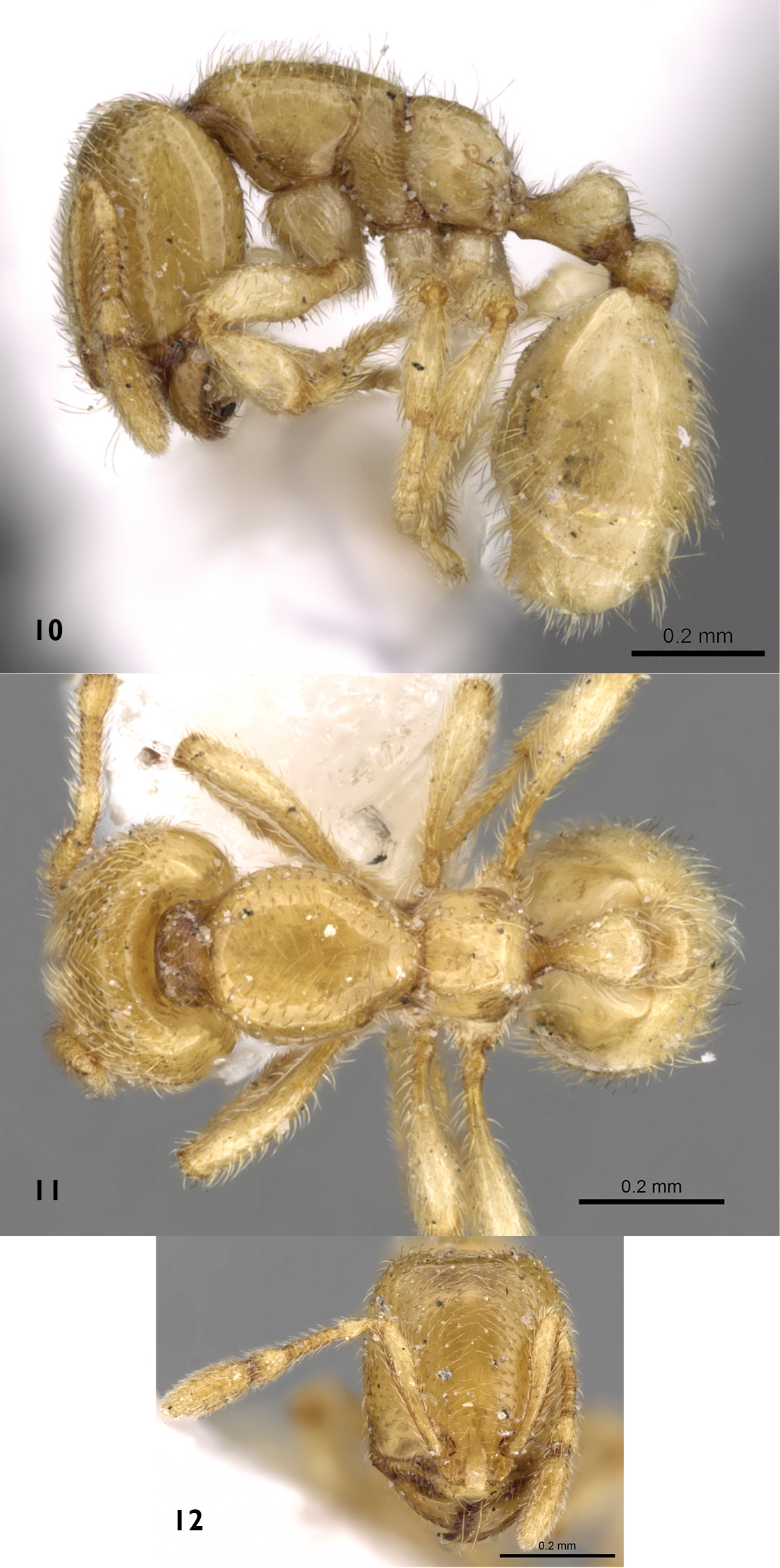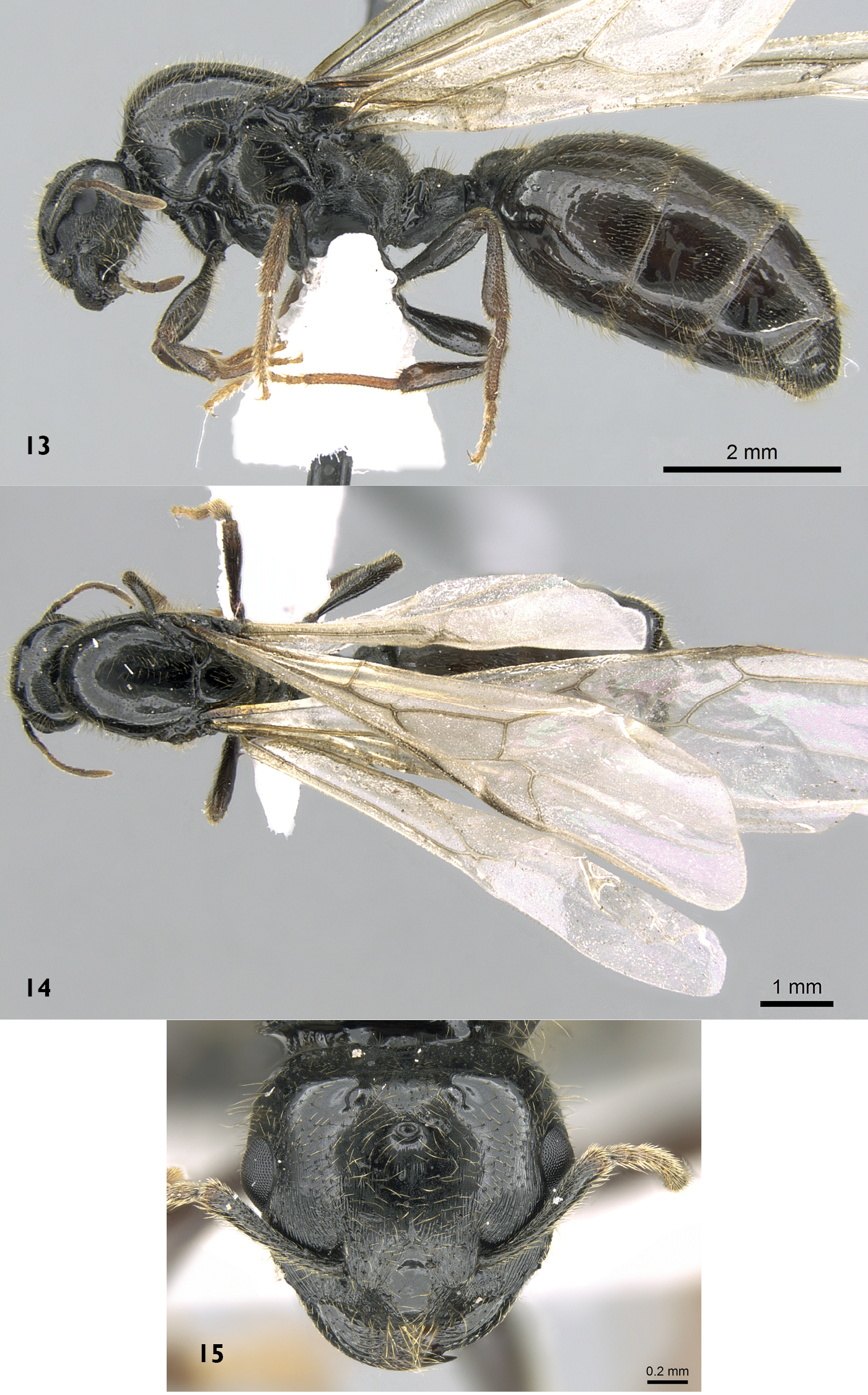






(C) 2013 Mostafa R. Sharaf. This is an open access article distributed under the terms of the Creative Commons Attribution License 3.0 (CC-BY), which permits unrestricted use, distribution, and reproduction in any medium, provided the original author and source are credited.
For reference, use of the paginated PDF or printed version of this article is recommended.
Citation: Sharaf MR, Aldawood AS (2013) The ant genus Carebara Westwood in the Arabian Peninsula (Hymenoptera, Formicidae). ZooKeys 357: 67–83. doi: 10.3897/zookeys.357.5946
The ant genus Carebara of the Arabian Peninsula is revised. Carebara abuhurayri Sharaf & Aldawood, 2011 is synonymized under Carebara arabica Collingwood & van Harten, 2001. Carebara arabica is redescribed and a Neotype is fixed based on a specimen collected from southwestern Kingdom of Saudi Arabia. A new species, C. fayrouzae sp. n. is described from Saudi Arabia based on queens, major and minor workers. Keys to major and minor workers of the two Arabian Carebara species are given.
Saudi Arabia, Palearctic region, Myrmicinae, key, taxonomy, new species
The ant genus Carebara Westwood, 1840, sensu
However, very little taxonomic or biological information is available on the genus Carebara throughout its range (
Carebara was originally recorded from the Arabian Peninsula by
Several nest series of a species very similar to Carebara arabica were collected from four different localities in the southwestern region of KSA. Minor and major workers matched the brief original description of Carebara arabica. In addition, two major workers of Carebara abuhurayri were collected from its type locality and are very similar to the major workers of Carebara arabica. Further comparisons of this newly collected material indicated that Carebara abuhurayri is a synonym of Carebara arabicus.
Minor workers of another Carebara species that appeared to be undescribed were collected from Riyadh, KSA. Repeated efforts to find nests of this species that contained all castes were unsuccessful; however, a colony that contained minor and major workers and several alate queens (males unknown) was collected in eastern KSA, confirming the novelty of this taxon.
In the present work, a new species, Carebara fayrouzae sp. n., is described based on queens, major, and minor workers. Carebara arabica is redescribed anddetailed new measurements are given. A Neotype of Carebara arabica from a locality in KSA Arabia near the Republic of Yemen is designated. Carebara abuhurayri is synonymized with Carebara arabica. Keys to major and minor workers of the two known Arabian Peninsula species are given.
TL Total Length (HL+ Mandible length+ ML + Petiole Length + Postpetiole length + Gaster length)
HW Head Width; maximum width of head behind eyes in full face view
HL Head Length; maximum length of head, excluding mandibles
SL Scape Length; excluding basal neck
EL Eye Length; maximum diameter of eye
ML Mesosoma Length; length of mesosoma in lateral view, from the point at which pronotum meets cervical shield to posterior base of propodeal lobes or teeth
PRW Pronotal width, maximum width in dorsal view
PL Petiole Length; maximum length measured in dorsal view, from anterior margin to posterior margin
PW Petiole Width; maximum width measured in dorsal view
PPL Postpetiole Length; maximum length measured in dorsal view
PPW Postpetiole Width; maximum width measured in dorsal view
SI Scape Index (SL × 100/HW)
CI Cephalic Index (HW × 100/HL)
All measurements are in millimeters and follow the standard measurements of
BMNH Natural History Museum, London, United Kingdom
CASC California Academy of Science Collection, San Francisco, California, USA
KSMA King Saud University Museum of Arthropods, King Saud University, Riyadh, KSA
MCZC Museum of Comparative Zoology, Harvard University, Cambridge, MA, USA
MHNG Muséum ďHistoire Naturelle, Geneva, Switzerland
NHMB Naturhistorisches Museum, Basel, Switzerland
SEMC Division of Entomology (Snow Entomological Collections), University of Kansas Natural History Museum, Lawrence, Kansas, USA
WMLC World Museum Liverpool, Liverpool, United Kingdom
| 1 | Smallerspecies (TL 1.77–2.76); antennae 10-segmented; concolorous brownish, antennae and legs yellowish; posterior margin of head strongly concave and posterior corners with a pair of teeth or horns, appearing blunt in profile; cephalic dorsum dull, with fine, dense, regular and longitudinal rugulae; lateral margins of postpetiole in dorsal view rounded | Carebara arabica |
| – | Largerspecies (TL 3.27–5.00); antennae 9-segmented; bicolored, head and mesosoma brownish, petiole and postpetiole brownish yellow, antennae, legs and gaster clear yellowish; posterior margin of head feebly concave and posterior corners rounded, without teeth or horns; cephalic dorsum smooth and shining except anterior part of head finely, longitudinally rugulose; lateral margins of postpetiole distinctly angular in dorsal view | Carebara fayrouzae sp. n. |
| 1 | Antennae 10-segmented; eyes minute, with a single ommatidium (present in all individuals); body pilosity subdecumbent or appressed and much scarce; anterolateral sides of head very finely longitudinally striated; lower halves of mesopleuron, metapleuron, petiole and postpetiole areolate-rugose; propodeal dorsum nearly half as long as propodeal declivity in profile | Carebara arabica |
| – | Antennae 9-segmented; eyes as rudimentary ommatidium (absent in some individuals); body pilosity erect to suberect and dense; entire body smooth without any type of surface sculpture; propodeal dorsum as long as declivity, appearing as a continuous curve in profile | Carebara fayrouzae sp. n. |
http://species-id.net/wiki/Carebara_arabica
Figs 1–6(3 major workers, 5 minor workers (CASENT0906368)) same data as the neotype; 6 major workers, 6 minor workers, SAUDI ARABIA, Wadi Bagara, 10.xi.2012, 18.79287°N, 42.01857°E, 436m, by leaf litter sifting (M. R. Sharaf leg.); 1 major worker, 9 minor workers, SAUDI ARABIA, Wadi Aljora, near Abadan, 12.xi.2012, 17.29263°N, 43.07010°E, 465 m, by leaf litter sifting (M. R. Sharaf leg.); 12 minor workers, SAUDI ARABIA, Fayfa, Agriculture Research Station, 6.iv.2013, 17.28671°N, 43.14390°E, 879m, (M. R. Sharaf leg.); 5 minor workers, SAUDI ARABIA, Fayfa, Agriculture Research Station, 5.iv.2013, 17.28671°N, 43.14390°E, 879m, (M. R. Sharaf leg.) [KSMA]; 1 major worker, SAUDI ARABIA, Al Bahah, Al Mukhwah, Zei Ein Archaeological Village, 19.9294°N, 41.4417°E, 741 m., 15.v.2011, (M. R. Sharaf Leg.); 1 major worker, SAUDI ARABIA, Al Bahah, Al Mukhwah, Dhi Ain Archaeological Village, 19.928°N, 41.4419°E ±50 m, 735 m., (B. L. Fisher Leg.), 23.ix.2011, Coll. Code BLF27577 [CASC].
Neotype major worker. TL 2.45, HL 0.71, HW 0.52, SL 0.26, ML 0.59, PRW 0.35, PL 0.15, PW 0.17, PPL 0.12, PPW 0.21, SI 50, CI 73.
Major workers. TL 1.77-2.76, HL 0.56-0.72, HW 0.44-0.52, SL 0.22-0.28, ML 0.49-0.63, PRW 0.29-0.35, PL 0.12-0.19, PW 0.12-0.17, PPL 0.11-0.18, PPW 0.14-0.25, SI 48-64, CI 69-80 (N=10).
Holotype major worker: TL 2.53, HL 0.75, HW 0.36, SL 0.63 (
Major worker. (Figs 1–3) Headrectangular (HL ~ 1.38 × HW) with strongly concave posterior margin and straight parallel sides; mandibles smooth and shining; masticatory margin armed with five teeth; eyes with a single oval ommatidium; anterior clypeal margin shallowly concave; antennae ten segmented with a two segmented club; scapes very short (mean SI = 54); posterior margin of head transversally carinate and posterior corners with a pair of outgrowths, appearing as blunt teeth in lateral view. Promesonotum strongly convex; metanotal area with apparent vestigial wing bases; metanotal groove deep; propodeal spines blunt, short and broadly based; petiole distinctly broader than long in dorsal view. Postpetiole clearly broader than long and broader than petiole in dorsal view. Gaster smooth and shining. Sculpture: cephalic dorsum and area in front of eyes finely densely regularly longitudinally rugulose; the ground-sculpture a fine, dense, conspicuous granulation; lateral cephalic dorsum from the posterior margin of eyes to posterior margin of head faintly and densely granulate; promesonotum smooth and shining; anepisternum smooth and shining; katepisternum and propodeum densely, transversely and conspicuously reticulate-punctate; petiole densely irregularly reticulate; postpetiole dorsum smooth and shining. Pilosity: head hairs long and sparse; petiole with two pairs of long backward directed hairs; postpetiole with three pairs of long hairs; gaster with few scattered long suberect hairs and abundant subdecumbent short hairs. Colour:concolorous brownish.
Carebara arabica, major worker. 1 body in profile 2 body in dorsal view 3 head in full-face view (antweb.org, CASENT0906367).
Minor workers. TL 0.99–1.13, HL 0.35–0.41, HW 0.29–0.32, SL 0.21–0.28, ML 0.31–0.34, PRW 0.17–0.19, PL 0.08–0.12, PW 0.07–0.08, PPL 0.05–0.07, PPW 0.08–09, SI 69–88, CI 74–89 (N=7).
Minor worker. (Figs 4–6) Head distinctly longer than broad (CI 74-89), with clearly convex sides and straight posterior margin; mandibles smooth and shining with relatively long yellow hairs and armed with four teeth; median portion of clypeus flat; in anterolateral view, clypeal lateral carinae strongly narrowed posteriorly between frontal lobes, then continued as a frontal triangle; eyes minute, with a single ommatidium; antennae ten segmented with a two segmented club; scapes broaden evenly from about mid-length and fail to reach head posterior margin by about one-third of the head length. Mesosoma in lateral view feebly convex; metanotal groove shallow but distinct, dorsally and laterally; propodeum obliquely angled; propodeal spiracle relatively large, circular, high and close to propodeal declivity; metapleural gland orifice prominent. Petiole longer than broad in dorsal view with short peduncle. Node of postpetiolelower than petiole and dorsally clearly convex and nearly as long as broad. Sculpture: Anterolateral sides of head very finely longitudinally striated; lower half of mesopleura, metapleura, petiole and postpetiole with areolate-rugose sculpture. Pilosity: appressed, cephalic dorsum with abundant scattered hair pits, few and short on mesosoma, petiole, postpetiole, and rare on first gastral tergite, underside of head with few short straight hairs. Clypeus with two pairs of standing hairs, central pair long and lateral pair shorter. Colour: Overall unicolorous yellow, smooth and shining.
Carebara arabica, minor worker. 4 body in profile 5 body in dorsal view 6 head in full-face view, (antweb.org, CASENT0906368).
A recent search conducted by the senior author and Tony Hunter (Curator of Entomology, WMLC) failed to locate any original type material of Carebara arabica at the cited depository (
Following the definition of
Carebara arabica was found in Fayfa, KSA nesting in leaf litter among Azadirachta indica A. Juss. (Meliaceae), Artocarpus heterophyllus Lam (Moraceae), and Rosadamascena Mill. (Rosaceae) trees and coexisting with an unidentified termite species. The other nest series from Wadi Bagara was found nesting in loose soil under roots of a Poaceae and near Acacia and Giant Milkweed, Calotropis procera (Aiton) (Asclepiadaceae). Other ants’ associates included Paratrechina jaegerskioeldi (Mayr, 1904); Tapinoma melanocephalum F., 1793, and Cardiocondyla sp. An interesting observation concerning a nest series from Zei Ein Archaeological Village included major workers, an uncommon phenomenon as compared to other nests found in Wadi Khat, Wadi Bagara, Wadi Aljora, and Fayfa. Two major workers were collected by digging in soil. Numerous minor workers were observed foraging above ground and exiting and entering tiny nest entrances in compacted humid clay soil. No major workers were observed foraging above ground.
http://zoobank.org/4E99379F-D985-4582-872A-A2B98D01F547
http://species-id.net/wiki/Carebara_fayrouzae
Figs 7–15Holotype major worker. SAUDI ARABIA, Al Qatif, El Naft, Eastern Province, 26.51028°N, 49.96889°E, 30 m. 23.iii.2012 (M. R. Sharaf Leg.) (MRS0066); King Saud University Museum of Arthropods (KSMA), College of Food and Agriculture Sciences, King Saud University, Riyadh, KSA.
Paratypes. 28 minor workers (CASENT0280994), 16 major workers (CASENT0280975), 4 queens (CASENT0906362) with same locality and data as the holotype (KSMA); a single paratype specimen of minor and major workers, and queen are deposited in MHNG; NHMB; CASC; MCZC; SEMC; WMLC; BMNH; 2 minor workers, SAUDI ARABIA, Riyadh, Alhaeir, 24.59214°N, 46.74522°E, 24.iii.2009, lemon soil, Berlese funnel (Acarology lab team at Department of Plant Protection, KSU Leg.); 4 minor workers, SAUDI ARABIA, Riyadh, iii.1989, Soil fauna (no collector data); 2 minor workers, SAUDI ARABIA, N. Riyadh, Ammaryia, 5.iii.2010, 24.806402°N, 46.428845°E, 681m, Lettuce soil fauna, Berlese funnel (Acarology lab team at Department of Plant Protection, KSU Leg.) These paratypes are in KSMA; 1 minor worker, SAUDI ARABIA, Riyadh, Mezahmia, Rawdat Kharara, 24.38931°N, 46.24211°E, 712 m. 30.i.2011, (M. R. Sharaf Leg.) (CASC); 1 minor worker, SAUDI ARABIA, Riyadh, Al Rowayda, 25.88016°N, 45.11563°E, 22.ii.2009, (M. R. Sharaf Leg.) (CASC) (All are paratypes).
Holotype major worker. TL 3.62, HL 1.10, HW 0.72, SL 0.37, EL 0.05, ML 0.87, PRW 0.50, PL0.20, PW 0.25, PPL 0.20, PPW 0.27, SI 51, CI 65.
Paratype major workers. TL 3.27–5.00, HL 1.00–1.20, HW 0.72–0.87, SL 0.32–0.42, EL 0.05, ML0.85–1.12, PRW 0.50–0.60, PL 0.20–0.27, PW 0.22–0.30, PPL 0.20–0.27, PPW 0.27–0.40, SI 38–53, CI 65–78 (N=15).
Major worker. (Figs 7–9) Head longer than broad (HL = 1.5 × HW), with feebly concave posterior margin, rounded posterior corners and parallel sides; masticatory margin of mandibles armed with four teeth; antennae nine-segmented; antennal scapes very short; clypeus narrow and with weakly concave anterior margin; eyes very tiny (in some individuals eyes absent); ocelli absent. Mesosoma in profile with distinct promesonotal suture; promesonotum feebly concave; metanotum small and narrow; dorsal face of propodeum continuously sloping and curving into declivity without spine or angle. Petiole in dorsal view little broader than long; petiolar peduncle short; petiolar ventral process distinct. Postpetiole in dorsal view nearly twice as broad as long, with acute lateral angles. Postpetiole in profile with distinct ventral process. Sculpture: Body smooth and glossy, anterior part of head finely, longitudinally rugulose, area between meso- and metapleura finely cross-ribbed. Pilosity: Head dorsum with scattered short hairs, rest of body with longer dense, yellow hairs. Colour:Bicolored species, head and mesosoma brownish, petiole and postpetiole brownish yellow, antennae, legs and gaster clear yellow.
Carebara fayrouzae sp. n., major worker 7 body in profile 8 body in dorsal view 9 head in full-face view (antweb.org, CASENT0280975).
Paratype minor workers. TL 1.66–1.94, HL 0.44–0.51, HW 0.29–0.44, SL 0.25–0.31, EL 0.007, ML0.49–0.53, PRW 0.22–0.31, PL 0.09–0.17, PW 0.09–0.14, PPL 0.07–0.09, PPW 0.09–0.12, SI 59–79, CI 78–100 (N=15).
Minor worker. (Figs 10–12) Head distinctly longer than broad, with straight posterior margin and parallel sides; masticatory margin of mandibles armed with four teeth; antennae nine-segmented; scapes when laid back from their insertions fail to reach posterior margin of head by about one third of head width; anterior clypeal margin nearly straight; eyes with only one ommatidium (absent in some individuals). Mesosoma nearly flat in profile; promesonotal suture indistinct; metanotal groove distinct; propodeal dorsum meeting declivity in a continuous curve; propodeal spiracle in profile high and located above midline of propodeum. Petiole in profile shortly pedunculate, with blunt ventral process and in dorsal view slightly longer than broad. Node of postpetiole in dorsal view clearly broader than long and in profile distinctly lower than petiolar node. Colour:Unicolorous clear yellow, hairy, smooth and moderately shining.
Carebara fayrouzae sp. n., minor worker 10 body in profile 11 body in dorsal view 12 head in full-face view (antweb.org, CASENT0280994).
Paratype queens. TL 9.75–10.75, HL 1.10–1.35, HW 1.45–1.50, SL 0.60–0.90, EL 0.35-0.45, ML3.25–3.50, PL 0.50–0.75, PW 0.65–0.70, PPL 0.50–0.60, PPW 0.85–1.00, SI 40–62, CI 107–136 (N=3).
Queen. (Figs 13–15) Body enormous, notably larger than minor and major workers. Head triangular, broader than long (HW = 1.2 × HL), with straight posterior margin and strongly convex lateral margins; masticatory margin of mandibles armed with four teeth; antennae nine-segmented; antennal scapes when laid back from their insertions reach level of posterior margin of eyes; anterior clypeal margin convex, eyes large and multifaceted (about 0.27 × HW); ocelli present. Mesosoma robust, pronotum not exposed above, lying entirely beneath the mesonotum; propodeum unarmed; remaining characters modified as in myrmicine queens. Petiole in dorsal view longer than broad. Postpetiole very broadly attached to gaster and node in dorsal view distinctly broader than long. Sculpture: Anterior half of cephalic dorsum with fine longitudinal striations extend to before posterior level of eyes; median portion of clypeus, posterior half of head, mesosoma and gaster smooth and shining, petiole and postpetiole superficially and finely shagreenate. Pilosity: Whole body covered with abundant, long, yellow hairs. Colour: Uniformly black, funiculi, tibiae and tarsi blackish brown.
Male. Not known.
Carebara fayrouzae sp. n., Queen 13 body in profile 14 body in dorsal view 15 head in full-face view, (antweb.org, CASENT0906362).
This new species is the second member of the genus recorded from the Arabian Peninsula. According to
This new species was found nesting in leaf litter under a large almond tree, Prunus amygdalus Batsch (Rosaceae) in a fenced area of a farm. The soil was composed of two layers, a thin upper clay layer organically enriched where most specimens were found foraging, and a lower thicker layer of loose sand where few specimens were found. Two beetle species were found coexisting with the ants, Oryzaephilus surinamensis (Silvanidae) and Cryptophagus acutangulus (Cryptophagidae).
This new species is dedicated to Fayrouz Sharaf (the daughter of the senior author).
The Arabian Peninsula is located on the line of contact between three major zoogeographical regions, the Palearctic, the Afrotropical and the Oriental regions; therefore, it is reasonable that it shares some faunal affinities with the mentioned regions. The central and eastern areas of the Arabian Peninsula belong to the Palearctic region with Eremic influence (
In spite of the mentioned faunal affinities, the probability of Carebara fayrouzae to be an introduced or invasive species, is unlikely for two reasons, first, the new species is well represented very much inland in central Arabian deserts (Riyadh and adjacent areas), second, it does not resemble any of the Asian species, (e.g. the Indian species) (
At present, two species of Carebara are now known from the Arabian Peninsula, Carebara arabica of the concinna species complex from the Republic of Yemen and KSA and Carebara fayrouzae sp. n. of the lignata species complex from KSA. The subterranean nature and nesting habit in decaying wood or leaf litter of this ant group (
This work was supported by Project No. 11-BIO1974-02, National Science and Technology Innovation Plan, King Saud University, with King Abdulaziz City for Science and Technology. The authors are much grateful to the subject editor Brian Fisher, Fernando Fernández and Boris Kondratieff for the useful comments and for Frank Azorsa (CAS) for useful discussions on Arabian Carebara. We thank Francisco Hita Garcia and Georg Fischer (CAS) for constructive criticism of the manuscript. We are much grateful to curators: Bernhard Merz (MHNG), Isabelle Zürcher-Pfander (NHMB), Brian Fisher (CASC), Edward. O. Wilson (MCZC), Michael S. Engel (SEMC), Tony Hunter (WMLC) and Barry Bolton (BMNH). Special thanks go to Michele Esposito and Estella Ortega (CAS, San Francisco) for help in photographing the new species, to Fahd Al Atawi (Acarology laboratory at department of plant protection, KSU) for providing some materials and to Mohammed Metwally for appreciated help in field trips.
